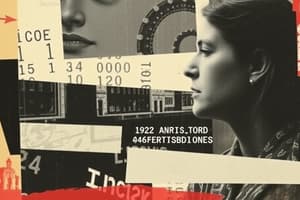Podcast
Questions and Answers
Which of the following is the most accurate definition of "multimedia" in the computer industry?
Which of the following is the most accurate definition of "multimedia" in the computer industry?
- Information solely composed of numbers and text.
- Information with only images and text.
- Information presented solely through video and audio.
- Information that contains a combination of numbers, text, images, audio, and video. (correct)
Data must be decompressed before it can be stored in a computer.
Data must be decompressed before it can be stored in a computer.
False (B)
What is the name of the universal representation that all data types are transformed into when stored in a computer?
What is the name of the universal representation that all data types are transformed into when stored in a computer?
bit pattern
In computers, whole numbers without a fractional part are called ________.
In computers, whole numbers without a fractional part are called ________.
Match the representation method with its respective characteristic regarding the storage of the decimal point.
Match the representation method with its respective characteristic regarding the storage of the decimal point.
Which of the following accurately describes an 'unsigned integer'?
Which of the following accurately describes an 'unsigned integer'?
In the sign-and-magnitude representation, the leftmost bit of an integer indicates the magnitude of the number.
In the sign-and-magnitude representation, the leftmost bit of an integer indicates the magnitude of the number.
What is the decimal value of the bit string 00101011 when it's stored in memory as an unsigned integer?
What is the decimal value of the bit string 00101011 when it's stored in memory as an unsigned integer?
In sign-and-magnitude representation, if the leftmost bit is _____ , the integer is positive.
In sign-and-magnitude representation, if the leftmost bit is _____ , the integer is positive.
Match the following bit patterns with their corresponding integers in sign-and-magnitude representation, assuming an 8-bit format.
Match the following bit patterns with their corresponding integers in sign-and-magnitude representation, assuming an 8-bit format.
What is the result of applying the one's complement operation to a binary number?
What is the result of applying the one's complement operation to a binary number?
Applying the one's complement operation to a binary number twice will not result in the original binary number.
Applying the one's complement operation to a binary number twice will not result in the original binary number.
What are the two-steps in taking the two's complement in binary?
What are the two-steps in taking the two's complement in binary?
In two's complement representation, the leftmost bit defines the sign of the integer. If it is 1, the integer is _________.
In two's complement representation, the leftmost bit defines the sign of the integer. If it is 1, the integer is _________.
Match the following bit patterns with their corresponding integers in two's complement representation, assuming an 8-bit format.
Match the following bit patterns with their corresponding integers in two's complement representation, assuming an 8-bit format.
Which of the following is generally true about two's complement notation?
Which of the following is generally true about two's complement notation?
Real numbers (with very large integral parts or very small fractional parts) should be stored in fixed-point representation.
Real numbers (with very large integral parts or very small fractional parts) should be stored in fixed-point representation.
Name the three parts that a floating-point number is made up of. Seperate each with a comma.
Name the three parts that a floating-point number is made up of. Seperate each with a comma.
To make the fixed part of the representation uniform in both scientific and floating-point methods, only one non-zero digit is used on the left of the decimal point. This is called ___________ .
To make the fixed part of the representation uniform in both scientific and floating-point methods, only one non-zero digit is used on the left of the decimal point. This is called ___________ .
Match each component of the floating point representation with its role
Match each component of the floating point representation with its role
What is the main purpose of the 'Excess system' in representing exponents in floating-point numbers?
What is the main purpose of the 'Excess system' in representing exponents in floating-point numbers?
According to the IEEE Standard, the point and the bit 0 to the left of the fixed-point section are stored.
According to the IEEE Standard, the point and the bit 0 to the left of the fixed-point section are stored.
What is the bias value for single precision floating point numbers under the IEEE standard?
What is the bias value for single precision floating point numbers under the IEEE standard?
In floating-point representation, the fractional part which, together with the sign, is treated like an integer stored in sign-and-magnitude representation is called the _________.
In floating-point representation, the fractional part which, together with the sign, is treated like an integer stored in sign-and-magnitude representation is called the _________.
Match the IEEE floating-point precision standard with its total bit size:
Match the IEEE floating-point precision standard with its total bit size:
The English language, for text, uses which of these?
The English language, for text, uses which of these?
MP3 is a dominant standard for storing audio and is short for Motion Picture Experts Group Layer 3.
MP3 is a dominant standard for storing audio and is short for Motion Picture Experts Group Layer 3.
What are the three steps to store audio?
What are the three steps to store audio?
The process that rounds the value of an audio sample to the closest integer value is called _________.
The process that rounds the value of an audio sample to the closest integer value is called _________.
Match the follow audio terms with their correct definitions:
Match the follow audio terms with their correct definitions:
What is the main difference between audio and photographs described in the text?
What is the main difference between audio and photographs described in the text?
In image storage, sampling is typically referred to as vectoring.
In image storage, sampling is typically referred to as vectoring.
What is image scanning rate in image processing called?
What is image scanning rate in image processing called?
The number of bits used to represent a pixel is called __________.
The number of bits used to represent a pixel is called __________.
Match the image encoding methods with the color scheme they use:
Match the image encoding methods with the color scheme they use:
Which of the following is considered a disadvantage of using a raster graphics?
Which of the following is considered a disadvantage of using a raster graphics?
Vector graphic image encoding stores bit patterns for each pixel
Vector graphic image encoding stores bit patterns for each pixel
Name the two different image storing techniques.
Name the two different image storing techniques.
In raster graphics, samples are usually called _________.
In raster graphics, samples are usually called _________.
Match the following main pieces programs use to draw circles with its explanation:
Match the following main pieces programs use to draw circles with its explanation:
Flashcards
What is multimedia?
What is multimedia?
Information containing numbers, text, images, audio, and video.
What is a bit pattern?
What is a bit pattern?
A uniform representation of all data types in a computer.
What are integers?
What are integers?
Whole numbers (numbers without a fractional part).
What is fixed-point representation?
What is fixed-point representation?
Signup and view all the flashcards
What are unsigned integers?
What are unsigned integers?
Signup and view all the flashcards
What is sign-and-magnitude representation?
What is sign-and-magnitude representation?
Signup and view all the flashcards
How do you know the sign?
How do you know the sign?
Signup and view all the flashcards
What is two's complement representation?
What is two's complement representation?
Signup and view all the flashcards
One's complementing
One's complementing
Signup and view all the flashcards
What is two's complementing?
What is two's complementing?
Signup and view all the flashcards
What are reals?
What are reals?
Signup and view all the flashcards
What is floating-point representation?
What is floating-point representation?
Signup and view all the flashcards
Normalization
Normalization
Signup and view all the flashcards
What is the exponent?
What is the exponent?
Signup and view all the flashcards
What is the Excess system?
What is the Excess system?
Signup and view all the flashcards
What is audio data?
What is audio data?
Signup and view all the flashcards
What is sampling?
What is sampling?
Signup and view all the flashcards
What is Quantization?
What is Quantization?
Signup and view all the flashcards
What is audio encoding?
What is audio encoding?
Signup and view all the flashcards
What is MP3?
What is MP3?
Signup and view all the flashcards
What are images?
What are images?
Signup and view all the flashcards
What are raster graphics?
What are raster graphics?
Signup and view all the flashcards
What is resolution?
What is resolution?
Signup and view all the flashcards
What is color depth?
What is color depth?
Signup and view all the flashcards
What is true-color?
What is true-color?
Signup and view all the flashcards
What are vector graphics?
What are vector graphics?
Signup and view all the flashcards
What is video data?
What is video data?
Signup and view all the flashcards
Study Notes
Data Storage Overview
- Data comes in various forms: numbers, text, audio, images, and video.
- Multimedia is the term used to describe information containing a combination of numbers, text, images, audio, and video.
Data Representation in Computers
- All data types are converted into a uniform bit pattern for storage and then transformed back to their original form upon retrieval.
Data Compression
- Data is typically compressed before storage to minimize memory space, as discussed in Chapter 15.
Error Detection and Correction
- Issues regarding error detection and correction during data transmission or storage are covered in Appendix H.
Storing Numbers
- Numbers are converted to the binary system before storage.
- Challenges include storing the sign of the number and indicating the decimal point.
Storing Integers
- Integers are whole numbers, lacking a fractional component.
- Fixed-point representation stores integers, where the decimal point position is fixed to the right of the least significant bit.
- The decimal point is assumed but not explicitly stored.
Unsigned Integer Representation
- Unsigned integers are non-negative.
- Stored by converting the integer to binary, then padding with zeros on the left if necessary to meet the required length.
- Example: Storing 7 in an 8-bit memory location involves converting 7 to binary (111) and adding five leading zeros, resulting in 00000111.
Overflow in Unsigned Integers
- Occurs when trying to store an integer larger than what a given memory location can hold
- Example: Storing an integer larger than 15 in a memory location that can only hold four bits (2^4 - 1 = 15)
Sign-and-Magnitude Representation
- The available range for integers is split into equal sub-ranges where the first half represents positive integers and the second half negative integers.
- The leftmost bit indicates the sign: 0 for positive, 1 for negative.
- +/- 28 can be stored in an 8-bit memory location. 0011100 & 1011100
Two's Complement Representation
- Almost all computers use two's complement
- It divides the range for an n-bit unsigned integer into two sub-ranges, which represent negative and non-negative integers.
- Determining the value uses the 0, the integer is positive / 1, the integer is negative principle
One's Complementing
- This reverses (flips) each bit to its inverse: A 0 becomes a 1 and a 1 becomes a 0.
- Applying this operation twice returns the original outcome
Two's Complementing
- Copy bits from the right until a 1 is copied, then flip the bits
- An alternative way to perform a two's complement is to do one's complement first and add 1 to the result.
- Example: storing +28 in an 8-bit location, it's transformation is decimal to binary and adding leading zeros.
- Negative 28 requires that we also perform the two's complement operation
Comparison of Integer Storage Systems
- Unsigned representation only stores positive value
- Sign & Magnitude and Two's Complement representations store negative numbers
Storing Real Numbers
- Real numbers have an integral and a fractional part.
- Recommended not be stored in fixed-point due to accuracy / precision
- Real numbers are stored using floating-point representation, which includes a sign, a shifter, and a fixed-point number.
- This method maintains accuracy or precision
Floating-Point Representation
- Includes a sign, shifter and fixed part number
Normalization
- Used make fixed parts of representation uniform
- both scientific and floating point methods use one non zero digit on the left of the decimal point
- In the decimal system this digit can be 1 to 9 and in binary it can only be 1.
Mantissa
- The mantissa is a fractional part that, put together with the sign, like an integer stored in sign-and-magnitude representation.
Binary System
- Both positive and negative integers store as unsigned integers in this system.
- A positive biases each number in order to shift them to the non-negative side e.g., Excess-7: biasing value is 7.
IEEE Standard
- The IEEE standard is used for floating-point representation, with single precision (32 bits) and double precision (64 bits) forms.
Exponent
- Is a power that shows how many bits the decimal point should be moved to the left or right, is a signed number.
Overflow and Underflow
- Occur in real number storage, alongside the means of storing Zero
Storing Text
- Text is stored as a sequence of symbols/characters.
Representing Text
- Text like "CATS" can be n-bit patterns where the pattern defines a single symbol
- Each bit pattern depends on the number of symbols
- Common codes include ASCII and Unicode
Storing Audio
- By nature audio digital data that are countable entities
- digital data differs from audio/ analog data
Sampling
- Selects only a finite number of points on the analog signal, measure their values, and record them
- We cannot record all the values in an audio sampling over an interval.
Quantization
- Approximates the value of each sample to the closest integer value.
Encoding
- Encodes quantized sample values as bit patterns.
- Bit depth (B) represents the number of bits per sample.
Bit Rate
- Number of samples per second (S) times the number of bits per sample, (B).
- For example, using 40,000 samples / second and 16 bits per sample gives a bit rate of 640,000 bits / second.
Standards for sound encoding
- MP3 (MPEG Layer 3) uses 44,100 samples / second and 16 bits / sample
Storing Images
- Stored using raster graphics and vector graphics.
Raster Graphics
- Also known as Bitmap graphics
- Suited for storing analog images of data that's intensity varies.
- Sampling is called scanning, with pixels being picture elements.
Resolution
- Density of pixels in an image or the scanning rate
Color Depth
- The number of bits used to represent a pixel
- Color perception is how eyes respond to a light beam
- RGB is the three primary colors red, green, and blue
True Color
- Uses 24 bits to encode a pixel
- Example: Some colors in True Color are Red (255,0,0), Green (0,255,0), and Blue (0,0,255).
Indexed Color
- Also known as Palette Color.
- It Uses only a portion of the colors
Image Encoding Standards
- JPEG uses the True-Color scheme combined with compression
- GIF images often utilize indexed color schemes
Vector Graphics
- Unlike raster graphics do not save bit patterns for each pixel meaning the file size is small
- Images are geometric shapes e.g., radius and equation of circle
Storing Videos
- Stored as frames over time
- Combination of stored images representing the video.
- Video compression methods are in chapter 15
Studying That Suits You
Use AI to generate personalized quizzes and flashcards to suit your learning preferences.




